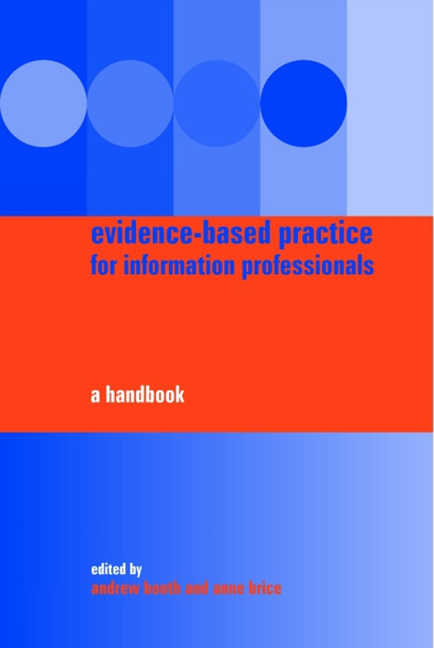Book contents
- Frontmatter
- Contents
- Foreword
- Editors and contributors
- Part 1 The context for evidence-based information practice
- 1 Why evidence-based information practice?
- 2 A brief history of evidence-based practice
- 3 Evidence-based information practice: a prehistory
- 4 How good is the evidence base?
- 5 Why don't librarians use research?
- Part 2 Skills and resources for evidence-based information practice
- Part 3 Using the evidence base in practice
- Index
3 - Evidence-based information practice: a prehistory
from Part 1 - The context for evidence-based information practice
Published online by Cambridge University Press: 08 June 2018
- Frontmatter
- Contents
- Foreword
- Editors and contributors
- Part 1 The context for evidence-based information practice
- 1 Why evidence-based information practice?
- 2 A brief history of evidence-based practice
- 3 Evidence-based information practice: a prehistory
- 4 How good is the evidence base?
- 5 Why don't librarians use research?
- Part 2 Skills and resources for evidence-based information practice
- Part 3 Using the evidence base in practice
- Index
Summary
Introduction
Although the contribution of evidence to information practice has only been recognized in recent years, librarianship has a long pedigree in practitioner-based research. The first known cohort study in health librarianship was reported in 1946 and other health librarians adapted the basic cohort design to answer important questions during the 1950s and early 1960s. The first randomized controlled trial (RCT) in health librarianship took place during the late 1970s. A small but identifiable stream of such studies continued during the early 1990s (see Box 3.1).
Thus, health librarians can point to use of research designs such as cohort studies or RCTs even before ‘evidence-based medicine’ was first reported.
This chapter charts the development of practitioner-led research as a fundamental platform for evidence-based librarianship (EBL) and the broader, evidence-based information practice (EBIP). It considers where EBIP has come from, examines major historical developments, and highlights a few individual contributions in our search for the early origins of EBIP.
In the beginning …
… was a question. Evidence-based information practice (EBIP) existed as a concept long before it became a label. A long time ago someone working in a library asked, ‘Is this really the best way to do this?’ Or, perhaps they wondered, ‘Why don't we try doing this a new way instead of the way we have always done it?’ Or, perhaps they asked, ‘Why don't more people use our library?’ What happened next probably depended upon how their manager (or some other person in authority) reacted to their questioning of conventional wisdom. The identity of that first librarian is lost to the obscurity of time.
Early EBIP antecedents
The roots of EBIP pre-date the modern international movement and may be traced in the histories of the profession and biographies of noted librarians, professional ‘ancestors’ who exhibited, at times, one or more of its defining characteristics. Surveying the past 5500 years, however, historian James Thompson (Thompson, 1977) makes the humbling observation that: ‘The development of libraries and librarianship has not been some kind of evolutionary process whereby these have grown better and better’.
Information
- Type
- Chapter
- Information
- Evidence-based Practice for Information ProfessionalsA Handbook, pp. 24 - 35Publisher: FacetPrint publication year: 2004
Accessibility standard: Unknown
Why this information is here
This section outlines the accessibility features of this content - including support for screen readers, full keyboard navigation and high-contrast display options. This may not be relevant for you.Accessibility Information
- 2
- Cited by
